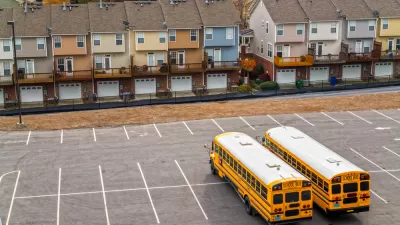And the result is fairly obvious - longer the commute, lower the reading. Well-being is a measurement of both physical and mental health, including ailments such as back pain and anxiety. No mention of modal type (e.g, driving, biking, transit).
In an ambitious attempt to chart physical and emotional well-being, Gallup has conducted extensive interviews with commuters. Gallup suggests some approaches that employers might take from the findings of the toll from longer commutes on workers' well-being.
"American employees report an average commute from home to work of 23 minutes. Those who do report long commutes are more likely to complain of several health problems. For example, one in three employees with a commute of more than 90 minutes say they have had a neck or back condition that has caused recurrent pain in the past 12 months
The psychological toll of long commutes may be as detrimental to individuals' wellbeing as the physical effects. Behavioral economists.... found that respondents' ratio of positive to negative emotions was particularly low during time spent commuting."
Gallup suggests that employers "who are hesitant to allow telecommuting, for example, may need to consider balancing the physical and emotional toll of long commutes against the social benefits of having employees together in the workplace. "
See the two charts: "Commuting Time and Physical Health" and "Commuting Time and Emotional Health" to see how the longer commutes result in declining results.
From "Gallup-Healthways Well-Being Index": "The Gallup-Healthways Well-Being Index™ "is the most ambitious effort ever undertaken to measure what people believe constitutes a good life."
Thanks to Matt Williams
FULL STORY: Wellbeing Lower Among Workers With Long Commutes

Maui's Vacation Rental Debate Turns Ugly
Verbal attacks, misinformation campaigns and fistfights plague a high-stakes debate to convert thousands of vacation rentals into long-term housing.

Planetizen Federal Action Tracker
A weekly monitor of how Trump’s orders and actions are impacting planners and planning in America.

San Francisco Suspends Traffic Calming Amidst Record Deaths
Citing “a challenging fiscal landscape,” the city will cease the program on the heels of 42 traffic deaths, including 24 pedestrians.

Defunct Pittsburgh Power Plant to Become Residential Tower
A decommissioned steam heat plant will be redeveloped into almost 100 affordable housing units.

Trump Prompts Restructuring of Transportation Research Board in “Unprecedented Overreach”
The TRB has eliminated more than half of its committees including those focused on climate, equity, and cities.

Amtrak Rolls Out New Orleans to Alabama “Mardi Gras” Train
The new service will operate morning and evening departures between Mobile and New Orleans.
Urban Design for Planners 1: Software Tools
This six-course series explores essential urban design concepts using open source software and equips planners with the tools they need to participate fully in the urban design process.
Planning for Universal Design
Learn the tools for implementing Universal Design in planning regulations.
Heyer Gruel & Associates PA
JM Goldson LLC
Custer County Colorado
City of Camden Redevelopment Agency
City of Astoria
Transportation Research & Education Center (TREC) at Portland State University
Jefferson Parish Government
Camden Redevelopment Agency
City of Claremont





























